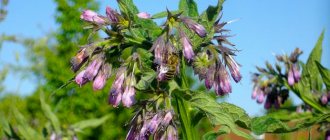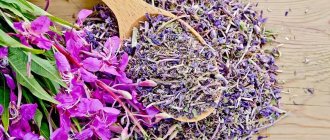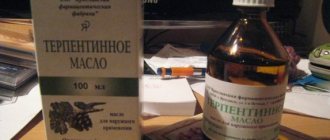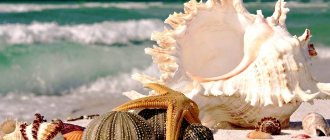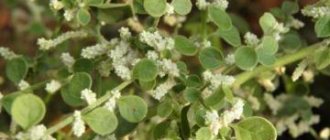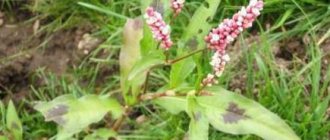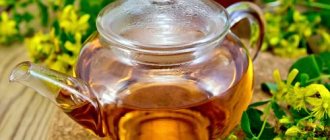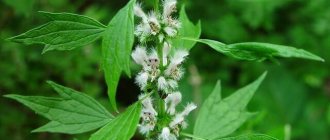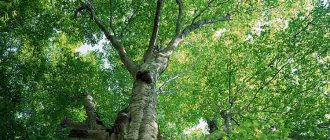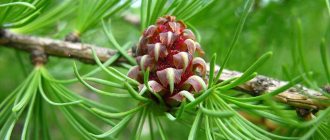Knotweed, whose official name is Knotweed, is an annual herbaceous crop 0.1-0.8 m high. It is a polymorphic species of the Knotweed genus. Popular names also include goose grass, bird's-grass, and ant-grass.
Cosmopolitan plant. It grows wildly in fertile soil and forms a continuous thick carpet, dominating other plants. It is unpretentious to conditions, therefore it grows on all continents and is not found only in Antarctica and the Arctic. Prefers trampled fields, paths, wastelands, river banks. Found everywhere in private farmsteads, along roads, on pastures, dry pastures, and ramparts. It grows well in weedy areas and is tolerant of trampling.
It is a medicinal plant and has food value for birds. It has long been widely used in traditional medicine recipes. Young leaves are used as a healthy addition to soups and salads, as well as for making purees. In Dagestan, a delicious filling for pies is made from knotweed leaves. Natural dyes are made from grass and roots.
The medicinal properties, contraindications and uses of knotweed will be discussed in this article.
What it looks like and where it grows
Bird knotweed, or knotweed, is a herbaceous annual from the Buckwheat family with long and branched recumbent stems. The shoots can reach 80 cm in length. The leaves of the plant are grayish-green, small, with short petioles. In July and August, knotweed blooms with small buds collected in bunches, and in mid-autumn it bears fruit - small dark nuts, similar to buckwheat seeds.
Bird's knotweed flowers are located almost close to the rosettes of leaf blades
Bird's knotweed is a very hardy plant and is found in almost every climate around the world. In Russia you can see it in the middle zone and in the Urals, in Siberia and in the northern regions, with the exception of the Arctic. Knotweed appears on the banks of reservoirs and along roads, on clay, sandy and even gravel soils, often forming a thick carpet near the soil surface.
Botanical description
What is knotweed? Polygonum aviculare - as the annual herbaceous plant is called in Latin - belongs to the genus Knotweed of the buckwheat family. Knotweed can grow up to 80 cm in height. According to the description, Knotweed has:
- thick, tap root;
- stem – up to 60 cm, with pronounced nodes, branched, creeping at the base;
- leaves are elliptical in shape, up to 5 cm long, up to 1.5 cm wide, grayish-green in color, with short petioles, with whitish membranous bells at the nodes.
Experts note that after flowering the stems become stiff. According to the description, the knotweed blooms from May to October. In this case, the following are observed:
- flowers in buds of 2-5 pieces, located in the axils of the leaves, small, have 3 pistils, 8 stamens, color – pink-green;
- the fruits are a flat triangle, black or brown, ripen from July to September, and are very loved by birds.
Where does knotweed grass live?
This plant is distributed throughout Russia, except in places with eternal ice. For knotweed, temperature and humidity do not matter; it is comfortable in any climate. The plant is resistant to trampling, it gravitates towards weedy places, easily tolerates natural disasters, and grows on any soil. Highlander can be found:
- along country roads;
- in the mountains;
- in gardens as a weed;
- in the gardens;
- near rivers;
- on sports grounds;
- at farmsteads;
- on pastures.
What does bird buckwheat look like?
The knotweed grass remains unchanged in color until autumn, forming an elastic carpet. The features of this medicinal plant are noted. Noteworthy:
- a long stem that extends along the ground may rise slightly;
- small flowers with five petals, green with a pink border;
- clusters of buds in the axils of leaves at different phases of blooming;
- oblong, large leaves of pale gray-green color.
Chemical composition of bird's knotweed
The health benefits and harms of knotweed are due to its rich composition. The flowers and leaves of the plant contain:
- antioxidants and flavonoids;
- ascorbic acid and vitamin K;
- tannins;
- tocopherol;
- zinc, chromium and cobalt;
- silicic acid;
- copper and manganese;
- resin and mucus;
- essential oil.
We recommend reading: Why does the body need zinc, where it is found, daily requirement
In folk medicine, bird knotweed is especially valued for its anti-inflammatory properties. Knotweed grass helps to quickly cope with negative processes due to its strong antiseptic effect.
Chemical components and vitamins
Knotweed includes a large number of biologically active components and vitamins. The plant contains:
- Tannins with anti-inflammatory and astringent properties.
- Essential oils, thanks to which knotweed helps to cope with wounds and ulcers.
- Fiber, carbohydrates and fats.
- Wound healing and disinfecting resins.
- Bitterness.
- Enveloping mucus.
- Silicic acid. A plant containing silicic acid helps restore the skin, as well as increase the strength and elasticity of the epidermis, bones, tendons and vascular walls.
- Flavonoids. They have a strong influence on bird knotweed and its medicinal properties. Avicularin quickly stops bleeding, and quercetin belongs to the P vitamins. It is a powerful antioxidant with anti-inflammatory, diuretic, antispasmodic and antiallergic properties.
- Magnesium, silicon, phosphorus, calcium, zinc.
- Ascorbic acid. Dried knotweed contains up to 0.9% vitamin C. This component regulates metabolism in the human body and serves as an antioxidant.
- Carotene is provitamin A, which increases the defense of the entire body.
- Tocopherol is vitamin E with immunomodulatory and antioxidant properties.
- Vitamin K. This component of knotweed increases blood clotting.
What are the benefits and benefits of knotweed herb?
Due to the numerous beneficial substances in the composition of knotweed:
- helps with pyelonephritis and kidney stones;
- alleviates the condition of inflammatory diseases of the genitourinary tract;
- has antimicrobial and antiseptic effects;
- disinfects wounds and cuts, stops bleeding;
- relieves itching and swelling after insect bites;
- improves the condition of blood vessels and equalizes blood pressure;
- prevents vitamin deficiency and anemia;
- stimulates blood circulation;
- speeds up digestion;
- has an anti-cold effect and reduces fever;
- removes toxic substances and waste from the body;
- serves as a prevention of cardiovascular diseases.
Bird's knotweed can be used externally to quickly heal cuts and abrasions. Compresses with herbs are good for bruises, bruises and sprains.
What are the benefits of knotweed for women?
Traditional medicine uses bird knotweed to normalize ovarian activity, improve blood flow in the pelvis, and even for the treatment of infertility. The medicinal properties of knotweed in gynecology are used for heavy and painful periods, to relieve the unpleasant symptoms of menopause. When used externally, the herb improves the condition of the skin and hair, helps cope with pimples and acne.
What is good for children
Decoctions and teas based on knotweed have a pronounced anti-cold effect and help strengthen the immune system. Bird's knotweed is used for diarrhea; the mild natural remedy has an astringent effect and stops diarrhea. But since the herb has contraindications and can be harmful, it is given only to adolescents over 12 years of age.
Knotweed contains slightly toxic substances, so it should be used with caution.
Attention! Before using birdweed for the first time, you should consult your pediatrician and make sure that the plant is safe for your child.
Medicinal properties of knotweed herb for men
Bird knotweed strengthens blood vessels and the cardiac system and protects men from strokes and heart attacks both in old and early age. The herb can be used for high blood pressure, to cleanse and restore the liver, and to relieve symptoms of intoxication after a stormy feast.
The anti-inflammatory and diuretic properties of knotweed are beneficial for genitourinary diseases in men. The plant is used to treat hemorrhoids and prostatitis. It should be noted that the latter often develops against the background of a lack of zinc. Bird knotweed contains this microelement in large volumes and serves as an effective preventive measure.
Methods of preparation and use
Traditional medicine offers several remedies based on medicinal plants for use. All of them have pronounced medicinal properties and improve the condition of the body.
Tincture
Alcohol tincture of bird knotweed is used externally for compresses and internally for diseases of the gallbladder and liver. The medicine is made in this way:
- 50 g of dried raw materials are poured with 200 ml of vodka or diluted alcohol;
- close the container with a lid and leave for only six hours;
- the finished product is filtered and poured into a clean glass vessel.
The strong tincture is consumed according to recipes in small dosages. The cake remaining after preparing the product can be used for compresses and lotions for skin irritations and injuries.
A single dosage of knotweed alcohol tincture should not exceed 30 drops
Infusion
A water infusion of bird knotweed has good healing properties. It is prepared according to this recipe:
- 50 g of dry grass is poured into 500 ml of warm water;
- cover the container with a lid and leave for two hours;
- strain the product.
You need to take knotweed on an empty stomach, take a large spoon three times a day. Drink it for bleeding, sluggish digestion and heaviness in the stomach.
Bird's knotweed in the form of an infusion is useful for hypoacid gastritis
Advice! To infuse the herb, it is better to use warm water, since in it the avian knotweed retains the maximum of useful substances.
Decoction
A concentrated decoction of the plant is used to treat pyelonephritis, liver diseases and inflammation of the genitourinary tract. Prepare the product according to the following recipe:
- 30 g of dry grass is poured into 200 ml of water;
- Boil on low heat on the stove for 15 minutes;
- the solution is filtered and cooled to a warm state.
You need to drink a large spoon three times a day, and the knotweed is taken for two weeks in total.
Bird knotweed decoction is best consumed on an empty stomach.
Tea
Bird's knotweed can be consumed instead of tea to strengthen the immune system and fight inflammation. The brewing method in this case is almost no different from the traditional one:
- three large spoons of chopped knotweed herb are poured into the kettle;
- pour the raw material with hot water at about 80 °C;
- Cover with a lid for infusion for half an hour.
The finished tea is poured into cups through a strainer. If desired, you can mix bird knotweed with other medicinal herbs.
Tea with bird knotweed can be consumed with honey
How to brew knotweed for kidney stones
Bird's knotweed is beneficial in the treatment of kidney inflammation and small stones. You can prepare this infusion:
- mix 5 g of dried horsetail and pikulnik;
- add 10 g knotweed;
- measure out a large spoon of the mixture and pour 250 ml of hot water.
The drink is kept covered for six hours, and then drunk cool in a full glass. You need to prepare this remedy twice a day.
Medicinal and beneficial properties
Medicines made with poultry buckwheat have antimicrobial, antitoxic, expectorant, and viscous effects.
In addition, these medications have choleretic and diuretic effects. Knotweed is an antitumor, hemostatic, anti-inflammatory and tonic, strengthening agent.
A natural remedy, when properly prepared, provides undeniable benefits and treats the following diseases:
- skin diseases;
- stomach and duodenal ulcers, gastritis;
- inflammatory processes and infections;
- tuberculosis;
- bleeding in the uterus and lungs, hemorrhoids.
Infusions also strengthen the body, relieve psychosomatic disorders, relieve swelling and help remove small stones from the kidneys. The benefits don't stop there.
The therapeutic effect and benefits of bird knotweed are also expressed in the following effects:
- contraction of the uterus;
- decreased vascular permeability;
- improvement of metabolic processes;
- increased blood clotting;
- removal of toxic substances;
- accelerated healing of bruises, abrasions and wounds;
- improvement of appetite.
Before using the plant, it is necessary to study contraindications, which will help avoid unwanted side effects.
Use of knotweed in folk medicine
Traditional medicine mainly uses knotweed in the treatment of inflammatory and gynecological ailments. When using medicinal herbs, you must carefully adhere to proven recipes.
Bird knotweed for prostatitis
For diseases of the prostate gland, the following medicinal collection is beneficial:
- mix knotweed, St. John's wort, dandelion and yarrow in equal quantities;
- add the same amount of clover, plantain, lingonberry, sweet clover and mint;
- measure out a large spoon of the mixture and pour 500 ml of boiling water.
Keep the product covered for an hour. Take the medicine 100 ml three times a day; the infusion can also be used for microenemas.
Knotweed for potency
Knotweed in combination with other medicinal herbs helps improve potency. For problems with libido in men, you can prepare the following infusion:
- mix 20 g of St. John's wort and bird's knotweed;
- add 15 g of oregano and elecampane root;
- add 10 g of lemongrass and yarrow;
- pour 400 ml of hot water into a large spoon of the mixture.
The drink is kept covered until it cools, and then filtered and taken four times a day, 50 ml. Therapy must be continued for 14 days.
Knotweed improves blood flow, thereby helping to normalize reproductive functions
Bird's knotweed for diarrhea
The beneficial substances in the composition of bird knotweed have a fixing effect on diarrhea. For the treatment of intestinal disorders, the following remedy is prepared:
- mix knotweed and oak bark in equal parts;
- pour 15 g of the resulting collection into 400 ml of liquid;
- bring to a boil over low heat, and then leave for half an hour.
You need to take the drink three times a day, 100 ml. In total, treatment is continued until the condition normalizes.
Bird's knotweed for joint ailments
The anti-inflammatory properties of the herb help with osteochondrosis, rheumatism and other inflammatory joint diseases. It is best to use an alcohol tincture, and make it like this:
- two small spoons of knotweed pour 250 ml of vodka;
- infuse the mixture for ten days;
- filter through cheesecloth.
The product should be taken internally three times a day, only 20 drops, diluting the medicine in a spoon of clean water. For severe pain, you can also use the tincture to rub joints; it will help restore mobility and reduce inflammation.
An alcohol tincture of knotweed, when rubbed, improves local blood flow and relieves swelling
Bird knotweed for fibroids
One of the indications for the use of bird knotweed is fibroids in women. The remedy is prepared according to the following recipe:
- mix 1/2 small spoon of celandine and 1.5 small spoons of water pepper;
- add two large spoons of knotweed;
- pour 350 ml of hot liquid into a thermos;
- insist for half an hour.
We recommend reading: Benefits of bell pepper, properties
The finished mixture should be strained and then drunk on an empty stomach three times a day. A single dosage should be no more than 100 ml, the total treatment time takes two weeks.
Bird knotweed for hemorrhoids
The herb bird knotweed is good for bleeding and can soothe pain. For hemorrhoids, it is customary to prepare the following infusion:
- three large spoons of knotweed pour 500 ml of water;
- keep covered for four hours;
- filter through a layer of gauze.
You need to take 100 ml orally on an empty stomach, three times a day. In case of severe pain and hemorrhoids, you can take warm baths with the addition of infusion, but in this case you will have to prepare it in a volume of 2-3 liters.
For those who want to lose weight
If you take knotweed, sugar returns to normal, metabolism is restored, and natural fat burning occurs. But at the same time, it is necessary to maintain proper nutrition, temporarily eliminating pasta, sweet pastries, potatoes, and rice. You need to prepare a useful elixir as follows:
- take dry ingredients in equal parts: knotweed, corn silk, rose hips;
- put everything in a thermos and pour 2 tbsp. boiled water;
- leave overnight, then drink 65 ml 3 times a day for 10 days;
- after 10 days, rest and do 2 more courses.
The functions of the composition include three directions:
- Knotweed normalizes metabolic processes.
- Corn flakes stimulate the removal of waste and toxins.
- Rosehip is a multivitamin composition to support the body.
How to drink and take knotweed
Bird knotweed helps improve well-being in kidney diseases and is even used in the treatment of infertility. Traditional medicine offers proven algorithms for using herbs.
How to drink knotweed to get pregnant
If you have difficulties conceiving, you can use a medicinal mixture with the plant. The recipe and instructions for using bird knotweed herb look like this:
- Mix 10 g each of meadowsweet and ordinary mantle;
- add knotweed, sweet clover and sage in a volume of 5 g;
- measure out a large spoon of the mixture;
- pour 250 ml of liquid into the raw material and boil for a quarter of an hour in a water bath.
The mixture is filtered from the sediment, the solution is added to the original volume and five drops of golden root tincture are added to it. The compound should be taken 80 ml on an empty stomach three times a day for ten days.
A collection of knotweed, sage and sweet clover stimulates the ovaries in women, promoting conception.
How to drink knotweed for kidney stones
If you have small stones in the kidneys, you can use a strong decoction of bird knotweed. They do it like this:
- three small spoons of dry herb are poured into a glass of water;
- boil the knotweed over low heat for 40 minutes;
- cool and filter the product.
You need to take 200 ml of the decoction in the morning. Treatment is carried out only if there is sand and small stones in the kidneys; if the stones are large, then you cannot try to remove them with diuretics.
How to drink knotweed for bladder inflammation
For cystitis, a diuretic infusion of knotweed helps relieve inflammation and eliminate pain. The drink is made like this:
- a large spoonful of herbs is brewed in a glass of boiling water;
- keep the solution for two hours;
- filter through cheesecloth.
You need to consume the product 70 ml three times a day, preferably on an empty stomach.
Sporysh: reviews
- Anna Semyonovna: “I have been suffering from kidney stones for a long time. I have tried so many folk remedies and expensive medicines from pharmacies! Out of hopelessness, I went to a herbalist, he recommended knotweed and told me how much and how to take it. At the last ultrasound they said that my stones, those that were there, became smaller, new ones did not appear. I don’t know if I owe this to knotweed or to the whole treatment as a whole, but I’m happy with the result.”
- Larisa: “For 10 years, my husband and I tried to have a baby to no avail. The doctors shrugged: they seem to be healthy, but God doesn’t give us children. My grandmother, a neighbor in my dacha, advised me to drink knotweed. I listened to her with the thought that things couldn’t get any worse. After three months there is a delay and two lines on the test. And now my daughter is already six months old.”
- Galina Stanislavovna: “My husband had prostate adenoma, they recommended surgery. Because of problems with blood and blood pressure, I was afraid to go under the knife. I read about knotweed and giving my spouse a decoction. The operation is no longer necessary."
- Mila: “I have such a story with knotweed! When my son was 5 months old, the milk disappeared and he switched to formula. And it caused the baby to have diarrhea. A more experienced friend advised him to give him a decoction of knotweed, saying that this was the only way she could help her children. And what do you think: the constipation has passed, but the cheeks have turned red. The doctor said we are allergic to this weed.”
Application in cosmetology
The medicinal properties of knotweed are valued in the cosmetic field. First of all, decoctions and infusions are used to treat problem skin; they help eliminate rashes, boils and acne. To combat acne and other rashes, you can also use a paste made from fresh leaves of the plant.
Healing solutions of bird knotweed help get rid of dandruff. If you wash your hair with a decoction every time after hygiene procedures, the oiliness of the scalp will quickly normalize, and seborrhea caused by excess sebum secretion will disappear. With the use of medicinal herbs, curls will become stronger and shinier.
Application for weight loss
Drinks based on knotweed speed up metabolic processes in the body and help get rid of toxins and excess fluids. You can use them on a diet. The products not only help you lose weight faster, but also normalize your appetite and improve the absorption of nutrients from food.
For weight loss purposes, you can prepare the following decoction:
- pour 250 ml of hot water into 15 g of dry raw materials;
- keep covered for three hours;
- filter.
Take 200 ml infusion each time shortly before meals.
On a diet, knotweed is consumed for up to ten days
Contraindications to the use of knotweed
The beneficial properties and contraindications of bird knotweed are determined by the individual condition of the body. For some diseases, it is better to avoid the herb entirely. You should not take knotweed:
- during pregnancy and lactation;
- for varicose veins and thrombophlebitis;
- in case of individual allergy to the plant;
- for chronic cardiovascular diseases;
- with a tendency to constipation;
- in the presence of large stones in the gall bladder and kidneys.
Important! Knotweed herb should be used in the treatment of diseases in strict accordance with the dosages indicated in the recipes, since it is slightly toxic.
Collection and preparation
It is recommended to collect leaves and stems of bird's-eye knotweed in May and June, when the raw materials contain the most useful substances. For harvesting, choose an ecologically clean area away from major roads and industrial facilities. On a dry and warm day, the leaf blades are carefully torn off or cut along with the stems. It is better not to touch the root system so that new knotweed can grow in the same place.
The collected raw materials are dried in the fresh air or indoors with good ventilation until the stems and leaves begin to break in the hand. The blanks are placed in paper bags or fabric bags and stored in a dark, dry place.
Knotweed retains its beneficial properties for up to three years.
